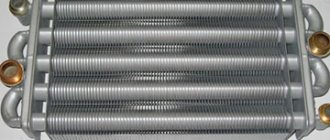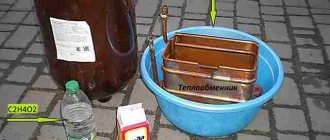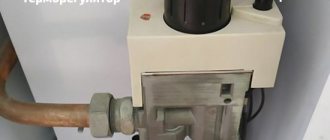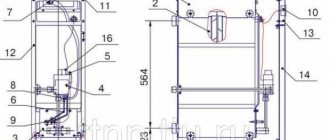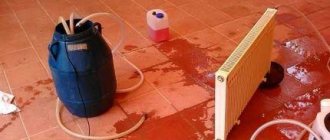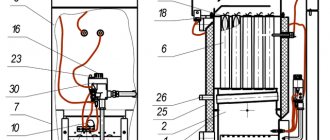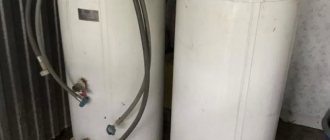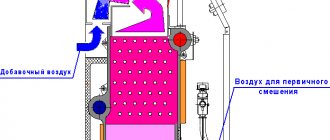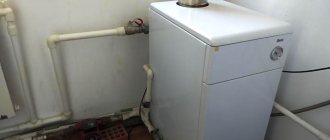Home / Gas boilers
Back
Published: 06/07/2019
Reading time: 5 min
0
6162
Installation of heating in household plots, in the absence of central heating systems, is carried out taking into account the available natural fuel in the region of location and its price.
Based on these criteria, today the cheapest source is gas, which makes the AOGV gas boiler one of the most promising types of individual heating.
The advantages are enhanced by the fact that such devices are easy to operate due to the absence of the need to load coal fuel, while ensuring complete combustion and protecting the environment from harmful emissions.
- 1 Decoding of AOGV
- 2 Advantages of AOGV boilers
- 3 Design and technical characteristics
- 4 Operating principle
- 5 Boiler manufacturers AOGV
- 6 Brief overview of models
- 7 Maintenance
General characteristics of AOGV boilers
The abbreviation AOGV stands for Gas Water Heating Unit.
Different manufacturers in the instructions for this technique allow for minor nuances and differences in the decoding of its name, but this does not affect the overall meaning.
If the letters of the name are followed by numbers, they indicate the power of the device.
Efficiency and temperature
If you plan to choose a heating boiler that guarantees maximum efficiency, then purchasing an AOGV is an absolutely justified step. It produces about 92% of maximum efficiency, which was achieved thanks to the special design of the heat exchanger.
These devices are used in heating systems operating using forced or natural movement of coolants. The main condition for the normal functioning of AOGV gas boilers is atmospheric pressure in the system, which does not exceed 1.4 atm. The operating temperature range of these heating devices is from 40 to 90 degrees.
Power
Modern boilers of the AOGV type have been known on the Russian market for about 15 years. As a rule, they are designed to heat rooms with a total area of about 200 square meters. and have a power of up to 30 kW. It is not practical to use such devices for heating rooms with a small area (less than 100 sq. m.).
These heating boilers are considered energy-independent and operate exclusively on the basis of natural gas.
Most often they are produced in a floor-standing version. The following models are most widespread on the domestic market:
- comfort;
- station wagon;
- economy
The choice of type of heating device depends on its price category and the size of the room.
Advantages of ZhMZ products
Any of the ZhMZ gas devices can operate independently of electrical networks - this allows you to expand the scope of their application. Advantages:
- Designed for the harsh Russian climate. Adapted to changes in water and pressure. Hardy, powerful, reliable, unpretentious.
- Can operate at very low pressure in gas and water supply systems.
- In severe frosts, they will ensure a comfortable temperature in the house.
- Highly reliable automation ensures high productivity of each unit and safe operation of all systems.
- Service life - 14 years or more. Warranty - 36 months.
- Capable of heating large areas.
- Some modifications can switch to liquefied gas.
Advantages and disadvantages of AGV
The list of positive qualities of AGV is as follows:
- Independence from electricity. This quality is often fundamental when choosing an AGV. The equipment in question does not require electricity at all to operate, so it will fit perfectly in situations where there are problems with electricity, or if there is a desire to save money on it.
- Cheapness. Compared to any foreign analogues, AGV wins in everything related to the cost of equipment. This advantage remains such even taking into account the extremely low efficiency of autonomous gas water heaters.
- Economical. AGVs are rightfully considered one of the most economical types of gas heating equipment.
The disadvantages of AGV come down to the following list:
- Big sizes. To install an AGV, about 1 m3 of space is required - which is quite a lot. Often a separate room is allocated for the installation of such equipment.
- Appearance. From a visual point of view, AGV is a purely utilitarian thing that does not have the slightest aesthetic value. In addition to the unpresentable appearance of the heater itself, the heating system is necessarily supplemented by large pipes and radiators, so you have to be sophisticated to create a good interior.
Foreign autonomous gas water heaters
Non-volatile boilers are popular. Imported units differ from AGV in a wide variety of models. However, more often these are floor heating devices. Wall-mounted options are rare.
But there is a variety like parapet non-volatile boilers. They can be installed on the floor or hung on the wall (but not higher than the window sill). There are models mounted on a vertical surface.
Imported non-volatile devices also differ in the materials from which the heat exchanger is made. For example, stainless steel, cast iron or copper. The latter is considered expensive, but also the most reliable and durable option. Copper is not used for the production of AGV.
The equipment of the Slovak brand Protherm is popular. The models are named after animals. The Protherm Bear 20 TLO boiler is considered practical and powerful. The device is equipped with a heavy cast iron heat exchanger.
The unit has a higher efficiency compared to AGV - about 90%. This model is suitable for heating a house with an area of up to 200 m² (excluding heat loss), although the power is 18 kW.
Among foreign devices, the Baxi boiler is popular. SLIM EF 1.22. The device is characterized by a high power of 22 kW, but the efficiency is lower than that of other imported units - 88%.
Operating principle of AGV
The main structural element of the AGV is the container in which the coolant is heated. When gas burns, a heat exchanger, made in the form of a pipe and installed inside the AGV housing, heats up. The heat from the heated pipe is transferred to the coolant, which is subsequently sent to the heating circuit.
Gas combustion products are discharged through a chimney built into the boiler design. All automation is a valve that opens the gas burner. Thanks to the operation of the valve, the required temperature is constantly maintained in the tank.
AOGV boilers also have an automation unit that turns off the device in case of a number of problems:
- Traction disorder;
- Significant reduction in gas supply pressure;
- The igniter stops burning.
Immediately behind the AGV, the following elements of the heating system are installed sequentially:
- Expansion tank;
- Heating devices located in each room requiring heating;
- Main pipeline providing distribution of heated coolant;
- Upper pipe distribution;
- Return pipe.
To know how an AOGV gas boiler works, you need to imagine the physical laws that arise in the heating system during its operation. The heated coolant has a lower density, which allows it to independently rise above the cold liquid. The coolant enters the main pipeline, is carried through the heating devices, gives off heat to them, and returns to repeat the heating cycle.
In AOGV boilers, the liquid moves by gravity, without any additional effort. If during the heating process the coolant expands too much, then its excess is drained into the expansion tank. This element is installed on the uppermost section of the heating circuit. When the temperature in the circuit decreases, the coolant returns to the OGV gas boiler.
To increase the efficiency of the system and make it more stable, you can supplement the AGV with a circulation pump, which forces the coolant to move forcibly and ensures more uniform heating of all sections of the circuit. It must be remembered that the pump requires electricity to operate - and the main advantage of the AGV is its independence from electricity.
SAFETY INSTRUCTIONS
Persons who have examined this passport are allowed to service the device.
Installation and operation of the devices must comply with the requirements of the “Rules for the design and safety of operation of hot water boilers, water heaters and steam boilers with excess pressure”, as well as the requirements of the “Safety Rules for Gas Distribution and Gas Consumption Systems. PB 12 - 529", approved by the State Mining and Technical Supervision of Russia.
The operation of the devices must be carried out in accordance with the “Fire Safety Rules for residential buildings, hotels, dormitories, administrative buildings and individual garages PPB - 01 - 03”.
Operation of the device is only permitted with properly functioning automatic safety and thermal control.
Gas safety automatics must provide:
- Reducing the gas supply when the water temperature in the heating system reaches the set value.
- Shutting off the gas supply to the main burner when the set heating temperature is exceeded.
- Turning off the gas supply to the device in the following cases:
- when the gas supply to the device is stopped (within no more than 60 seconds);
- in the absence of draft vacuum or in the boiler furnace (for a period of no less than 10 seconds and no more than 60 seconds);
- when the pilot burner flame goes out (within no more than 60 seconds).
When operating the device, the hot water temperature should not exceed 95 °C.
Prohibited:
- operate the device with the heating system partially filled with water;
- use other liquids instead of water as a coolant**;
- install shut-off and control valves on the supply line and pipeline connecting the heating system to the expansion tank;
- operate the device if there is a gas leak through the gas pipeline connections;
- use an open flame to detect gas leaks;
- operate the device if there is a malfunction of the gas network, chimney or automation;
- independently eliminate malfunctions in the operation of the device;
- make any design changes to the apparatus, gas pipeline and heating system.
When the device is not working, all gas valves: in front of the burner and on the gas pipeline in front of the device, must be in the closed position (the valve handle is perpendicular to the gas pipeline).
Any malfunctions when operating the device on gas must be immediately reported to the emergency service of the gas operating company.
If gas is detected in the premises, you should immediately stop supplying it, ventilate all premises and call emergency or repair services. Until the malfunction is eliminated, it is prohibited to light matches, smoke, or use
** It is allowed to use household coolant “Olga” (manufacturer: ZAO Organic Products Plant) according to the instructions for use. After a period of operation, the coolant must be drained and disposed of.
The manufacturer reserves the right to make changes to the design and appearance of the product. This technical documentation may differ from the description above; see the operating manual enclosed with each boiler upon purchase.
This page uses materials from the site
Gas boilers AOGV from JSC Borinskoe
The Borinsky plant produces rectangular heaters, with automation in the rear.
The second most popular manufacturer of AOGV is the Borinsky plant. It offers 7, 11, 17, 23 and 29 kW heaters. Such a wide range allows you to choose a boiler even for a small house up to 70 sq. m. This is convenient when there is no point in overpaying for a more powerful unit. At the same time, the Zhukovsky plant can offer customers gas boilers AOGV 11.6 - this is the minimum value.
The Borinsky plant produces two modifications of heaters:
- normal - single-circuit;
- combined - double-circuit.
Boiler burners are made of stainless steel. Copper DHW heat exchanger. The heater body is painted with polymer paint. The unit has built-in temperature regulators to prevent it from overheating, a thermocouple to control the gas supply, and a draft stabilizer. The latter smooths out differences during strong gusts of wind, and in the event of a complete lack of traction, it blocks the gas supply and, accordingly, the operation of the unit. Natural or liquefied gas is suitable as an energy carrier.
Brief overview of models
Zhukovsky Machine Plant sells AOGV in the range from 11.6 to 29.0 kW in 3 versions: economy, station wagon and comfort. They differ in the level of automatic control, completeness and the country of origin of the auxiliary equipment. All devices with piezo ignition for autonomy of the unit.
The OGV gas burner is made of stainless steel ensuring durability. The inner jacket of the hot water supply is made of copper, and the body is protected by polymer materials. The automation is equipped with temperature sensors and regulators to ensure a constant indoor air environment and prevent emergency conditions.
Automation equipment:
- Thermocouple for monitoring gas flow.
- Stabilizer of supply air to the firebox, to compensate for air changes in windy weather, which can tear the torch away from the burner.
Installation of AOGV in a heating system
AOGVs are installed in private homes.
Installing an AOGV in a private house will cost one and a half times less; on average, the cost of a heater is 20 thousand rubles. Such units can operate in both sealed and open systems. In the latter case, the circuit depends only on the gas supply; there are no energy-dependent devices in the boiler.
The do-it-yourself installation scheme for AOGV in a private house is standard. Consider a sealed circuit:
- the supply from the boiler goes straight to the radiators (air vents must be installed in them);
- a pump is placed on the return line in front of the boiler - installing a pump is allowed in any place, but on the return line it is more correct;
- A mud trap is placed in front of the pump along the coolant flow - this is mandatory;
- The expansion tank is also installed before the pump - this is necessary for the correct operation of the expansion machine.
In an open system, the expansion tank plays the role of an air vent. It can be placed on the supply, immediately above the boiler, or on the return. The main thing is that it is at the highest point. In gravity systems, certain slopes must be observed, then an electric pump is not needed. If the circulation in an open circuit is disrupted, then installing a pump will easily solve this problem; you can even not replace the expansion tank with a sealed one.
What is AOGV: decoding
Mechanical automation.
AOGV (interpretation: gas hot water heating apparatus) is a gas boiler that does not contain a single volatile element. That is, the unit can operate autonomously without electricity. They are usually installed where there is a central gas pipeline, but even in the absence of gas, you can change the burner, which will run on propane-butane. In the heater marking there are always numbers after the abbreviation - this is the maximum power. For example, AOGV 17 means that the maximum thermal power of the unit is 17 kW.
Main elements of the heater:
- automation;
- thermocouple;
- combustion chamber;
- heat exchanger;
- chimney.
Absolutely all AOGVs of the Borinsky and Zhukotsky plants are floor-standing (installed on the floor).
The operation of the AOGV boiler is controlled by mechanical automation. Domestic heaters can be equipped with automatic equipment of their own (in cheaper models), European or American production. This is the heart of the heater; without automation, the boiler cannot operate. The second important element of the heater is a copper thermocouple. It is responsible for activating the solenoid valve, which shuts off the gas supply if the burner wick goes out.
Unlike modern parapet heaters, AOGV gas boilers are equipped with an open combustion chamber. The disadvantage of such chambers is that they take air from the room in which they are located to maintain the fire. The advantage is the ability to exhaust smoke through a regular chimney with natural draft; there is no need for an energy-dependent fan.
The heat exchanger is located at the top of the combustion chamber, directly above the burner. Each circuit has its own heat exchanger; the fluids in them do not intersect. That is, if the heater is intended not only for heating the room, but also for preparing hot water, then there will be two heat exchangers.
Gas heating of a house in a village is sometimes impossible due to the lack of gas supply. People have to look for an alternative.
An electric stove is suitable for heating a home in this capacity. Details here.
AGV modifications
Considering the variety of modifications of gas water heating devices on the market, it is worth understanding how the AOGV differs from a gas boiler. Looking ahead a little, there is no fundamental difference between the devices; all the differences lie in small nuances.
If we talk in detail, then everything that distinguishes an AOGV from a boiler comes down to the following points:
- Glass thermometers have been replaced with modern Italian components;
- Honeywell products began to be used as automation elements;
- The design is supplemented with a piezo ignition device;
- The last difference between the AOGV and the boiler is that the appearance of modern modifications has been slightly improved, for which a higher quality coating has been used.
About old-style boilers
AOGV is a later modification of the AGV brand. They, like their predecessors, do not have particularly high efficiency and do not have thermostat control. When gas was cheap, no one paid attention to low performance; today efficiency is one of the most important characteristics when choosing heating equipment. AGV models were distinguished by low-quality automation, which broke after one or two seasons of operation.
AGV and AOGV can work without automation: if it breaks down or is turned off on purpose, it will not interfere. When buying a heating boiler, you need to take care of a sufficient number of pipes - their diameter should not be less than two inches. If you take a smaller diameter, the circulation of the coolant may deteriorate - there will be additional costs for heating it.
What is the improvement?
The developers have made a number of improvements to the design:
- Glass thermometers were replaced with Italian, more modernized ones.
- German automation from Honeywell was installed.
- Piezo ignition.
- The appearance has improved thanks to the high-quality coating. The design has changed: the body can be round or rectangular. White color. Painting: powder.
Energy and energy equipment
Research Institutes of Energy Energy companies Energy saving technologies Sale of heating boilers Repair of heating boilers Cleaning of boilers and heat exchangers Design and construction of boiler houses Boiler equipment - production, sale, repair Construction of energy facilities Construction, repair and maintenance of energy facilities Power plants - equipment Diesel power plants, sale RusHydro Pipes and pipeline fittings Electrical installation work Cable industry enterprises Electrical products, sales Gas industry, gas equipment Oil and gas industry - enterprises in Moscow Sale and transportation of petroleum products Petrochemical enterprises Energy audit Energy equipment Air conditioners and fans, sales Electrical goods stores Leroy Merlin electrical goods
Boilers of these brands are produced
by the Zhukovsky Machine-Building Plant (ZhMZ)
, the largest enterprise in Russia producing household gas heating boilers.
Therefore, these boilers are often called Zhukovsky
.
ZhMZ is located in Zhukovsky, Moscow region. Since 1967, the plant began producing household heating boilers AGV-120, widely known in all regions of Russia and the CIS countries. Currently, the plant produces more than 30 types of AOGV, AKGV and KOV with power from 11 to 68 kW. Zhukovsky boilers are used in electrically independent autonomous water heating and water supply systems. New modern equipment and highly qualified personnel allow us to produce competitive products and the plant to be the Russian leader in the production of gas equipment for autonomous heating and water supply systems. Boiler AOGV-17.4 Gas floor-standing boilers AOGV
are used for heating residential buildings and domestic premises in heating systems with natural or forced water circulation.
The boilers are single-circuit and are used only for heating. For hot water supply, a double-circuit analogue is used - AKGV boilers
.
The abbreviation “AOGV”
stands for
“Gas Heating Unit”, “AKGV - “Combined Gas Unit”.
Those. The AOGV boiler is used only for heating, while the AKGV boiler allows for the selection of hot water for domestic needs. The boilers operate on natural gas, and when replacing nozzles (on the main burner and igniter) - on liquefied (cylindered) gas. The boiler heat exchanger is steel. It has a special design that allows achieving a boiler efficiency of at least 89%. The model range of AOGV boilers includes devices with a power from 7 to 23.2 kW and allows you to heat rooms with an area of 25 to 200 m2. The AKGV boiler range includes devices with a power from 11.6 to 23.2 kW and allows you to heat rooms with an area of 50 to 200 m2. The distinctive qualities of boilers of these brands are simplicity and reliability of design, unpretentiousness, and ease of use. These qualities allowed the AOGV and AKGV boilers to gain popularity in Russia. The AOGV boiler can be found in many country houses and in houses with apartment heating. Gas heating boilers AOGV and AKGV can be used both in systems with natural circulation of coolant (open system), without connection to the electrical network, and in systems with forced circulation of coolant (closed system) with the installation of a circulation pump. Based on serial boilers AOGV and AKGV, it is possible produce modular boiler houses of various capacities When AOGV and AKGV boilers operate in the heating system, low-freezing liquids recommended for use in heating systems can be used as a coolant
Design Features
- Fire adjustment is made in two ways: automatically and manually. The models differ not only in power, each of them has a certain range of capabilities.
- Some models have a pump to circulate water in the pipes. This allows you to effectively heat the room due to uniform heat distribution. Cheaper modifications do not have pumps, and water circulates according to the laws of physics. Therefore, when installing such boilers, the pipes are mounted at an angle.
- All modifications have an expansion tank. It allows you to achieve optimal pressure in the system, and if the liquid expands due to strong heating, it stores its excess.
Varieties
All boilers at the Zhukovsky Plant are floor-standing. There are three modifications:
- "Economy";
- "Universal";
- "Comfort".
In the first case, automation manufactured in the Russian Federation was used, in the other two - foreign ones. The brand presents only single-circuit versions - for heating buildings; double-circuit versions are not produced at ZhMZ.
Device
The efficiency of the equipment is 89%, which is quite good for domestic products. This productivity can be achieved due to the original design of the heat exchanger. The cast iron heat exchanger is equipped with turbulators. The burner is atmospheric, air comes from the room. Thanks to automation, continuous operation for a long time is ensured.
Heaters from the Zhukovsky Plant have a number of innovations that increase their environmental friendliness. Developers are trying to keep up with global trends, but still, domestic products are far from achieving the indicators of European and some Asian competitors. But Russian products have an undeniable advantage - a low price that satisfies all consumers.
Insertion of AOGV into heating
Since it is not difficult to include AGV in home heating, you can do it yourself, but you will first need permission from the utility services. The insert involves connecting the unit to the heating pipes, as well as to the gas main. To prevent scale particles and dirt from getting inside the boiler, coarse filters must be installed on the inlet pipes. All threaded connections are sealed using tow and O-rings.
Shut-off valves are installed on water pipes. Only a person who has permission to do this type of work can connect the boiler to the main gas line. The gas pipe is also connected with additional sealing. When connecting, copper products or corrugated hoses are used.
Rubber parts are not used because over time they crack and can leak gas, which, if accumulated in the room, will lead to disastrous consequences. A union nut is used to secure the corrugated hose.
Selection rules
The quality of a purchase largely depends on whether it was chosen correctly in a particular case
In addition, it is important to immediately ask the seller for documents for the equipment. Firstly, this makes it possible to verify the originality of the model
Secondly, the technical passport contains a lot of information regarding how to properly handle the boiler. If the seller, under any pretext, tries to evade showing such documents, then you should quickly run away from this store. This means that they sell handicrafts and purchasing a boiler here is a serious risk for the safety of residents.
Now you should pay attention to the selection criteria:
- The size of the heated room. Depending on the quadrature, the power of the device is selected. To calculate this parameter, you can use an approximate formula - 1 kW x per 10 sq.m. premises. But this figure will be approximate. Experts advise taking a 5% reserve. The region must also be taken into account in this matter. If it is northern, then in order for the house to have a body it is worth adding another 20-25%. For warm regions, the optimal figure is 0.7-0.9 kW, and for cold regions - 1.5-2 kW.
- Heat loss. Installation of a heating system should begin with insulation of the entire house. This issue is important for owners of private houses and corner apartments. Here 15% is added to the initial power of the unit.
- Load. There are single-circuit boilers (intended only for heating) and double-circuit boilers (provide not only heat, but also hot water). Depending on the situation, a specific model is selected. But you should immediately be prepared that single-circuit boilers are cheaper than double-circuit options.
- Pipeline. The efficiency of heating also depends on the pressure of the coolant and the resistance of the pipes. Here it is recommended to take into account the total length of the forward and return pipelines. The cheapest boilers are made of steel, while the more expensive ones are made of stainless materials. If this is a floor-standing model, then the best option would be a cast iron heat exchanger.
The power of the gas boiler varies from 11 to 35 kW. Having studied all these questions, you can choose the most effective heating system.
Main operational characteristics of the AOGV and AKGV boilers
Boiler brandThermal power, kWAutomationHeating square, m2Weight, kgAOGV-7-3 AOGV (AKGV) -11.6-1 AOGV (AKGV) -11.6-1 SIT AOGV (AKGV) -17.4-1 AOGV (AKGV) -17.4-1 SIT AOGV (AKGV) -23.2-1 AOGV (AKGV) -23.2-1 SIT AOGV (AKGV) -23.2-1 SIT with Zhukovsky connection AOGV (AKGV) -29-1
| 7 | EUROSIT | 25-60 | 40 |
| 11,6 | Orion | 40-90 | 45 |
| 11,6 | EUROSIT | 40-90 | 45 |
| 17,4 | Orion | 70-140 | 50 |
| 17,4 | EUROSIT | 70-140 | 59 |
| 23,2 | Orion | 90-200 | 54 |
| 23,2 | EUROSIT | 90-200 | 54 |
| 23,2 | EUROSIT | 90-200 | 54 |
| 29 | Nova SIT | up to 250 | 58 |
Manufacturers of boilers AOGV and AKGV
.
The Boiler Equipment Plant OJSC Borinskoye
has been producing AOGV boilers for more than 15 years and during this time has made a number of significant changes to the basic design of the boilers. Improvements such as: •modern design of the heat exchanger and gas burner device, •increased efficiency, •possibility of installing a copper circuit, •use of imported automation, •polymer painting,
Foreign autonomous gas water heaters
Non-volatile boilers are popular. Imported units differ from AGV in a wide variety of models. However, more often these are floor heating devices. Wall-mounted options are rare.
But there is a variety like parapet non-volatile boilers. They can be installed on the floor or hung on the wall (but not higher than the window sill). There are models mounted on a vertical surface.
Imported non-volatile devices also differ in the materials from which the heat exchanger is made. For example, stainless steel, cast iron or copper. The latter is considered expensive, but also the most reliable and durable option. Copper is not used for the production of AGV.
The equipment of the Slovak brand Protherm is popular. The models are named after animals. The Protherm Bear 20 TLO boiler is considered practical and powerful. The device is equipped with a heavy cast iron heat exchanger.
The unit has a higher efficiency compared to AGV - about 90%. This model is suitable for heating a house with an area of up to 200 m² (excluding heat loss), although the power is 18 kW.
Among foreign devices, the Baxi boiler is popular. SLIM EF 1.22. The device is characterized by a high power of 22 kW, but the efficiency is lower than that of other imported units - 88%.
New generation of AGV devices
Russian factories produce AOGV - 23.2 - 1. This is a household heating gas cylinder. It is intended for heating houses with an area of 140 - 200 square meters. meters. There is also a device with slightly less power for heating an area of 100 - 140 square meters. m. Otherwise, these two types of heaters are practically no different from each other.
Recently, a more modern model AKGV - 23.2 - 1 with a water circuit has appeared. It can also be used to heat a home and supply hot water. And instead of a pipe running inside the boiler, three steel sections are installed, which are made using a special stamping method and are hollow inside. The sections are mounted vertically and are connected into one chimney, through which gas combustion products flow into a separate chimney pipe.
How to choose gas heating boilers?
New generation of AGV devices
Water is heated using a special coil, which encircles the entire circuit inside the boiler and the water that is used for everyday life flows through it. And in the boiler the water for heating is also heated. That is, it turns out that this device is two in one.
The new model includes an injection burner, which ensures efficient combustion of gas without residue. This type of burner works perfectly even when the gas pressure in the pipeline is low.
Operating principle
All AOGV boilers look like a single-circuit mechanism, which is equipped with an internal atmospheric burner. The maximum coverage of the heated surface in such boilers is ensured by the energy of the combustion gas. This happens thanks to special micro-torch burners.
At the bottom of the boiler, directly under the tank with the heat exchanger, there is a gas burner, with the help of which the water is heated. With a slight modernization of the device, it can be operated using liquefied gas.
The steel heat exchanger has a tubular configuration, which ensures high efficiency of the equipment. In the rear area of the gas boiler there are outlet and inlet fittings with a diameter of approximately 4 cm, intended for connecting a heat carrier. At the bottom of the device there is a return line, and at the top there is a so-called “direct” line.
The chimney has a diameter of about 120 mm and is connected to the top of the device.
The unit is controlled using a valve with electromagnetic properties and a thermostat lever. Sometimes boilers with piezo ignition or automatic start are produced. A thermocouple and a draft sensor are connected to the valve. The copper thermocouple controls the presence of fire at the igniter and is considered an important component of the boiler. The draft sensor is capable of shutting off the flow of gas if the draft decreases.
Automation of the new AGV
It completely controls the entire process of heating water. And the automation unit itself consists of:
- a temperature sensor that controls the water temperature;
- an electromagnet, which is responsible for controlling the main gas supply valve;
- thermocouple, which is mounted near the igniter. Heated by a constantly burning torch, it creates an electric current in the circuit;
- traction sensor. It is mounted in the chimney and controls the optimal draft of the pipe.
About AOGV manufacturers
Gas boilers are produced by several Russian companies. All of them are at approximately the same level in terms of design, performance and cost.
A wide range of boilers on the market include AOGV Lemax (Taganrog), Siberia (ZAO Rostovgazoapparat), Borinskoye (Moscow region), Angara Lux (Taganrog), etc. The minimum power of gas units is 5 kW , maximum – 35.
For example, the AOGV 11.6 boiler, the technical characteristics of which are not inferior to foreign ones, is produced in Rostov and Zhukovsky.
Modernization of AGV boilers by the manufacturer
The boiler manufacturer AGV was in no hurry to discontinue them due to obvious advantages.
However, taking into account that this equipment needed a thorough modernization, the following design changes were made:
- Fragile glass thermometers have been replaced with more reliable instruments made in Italy;
- The new systems were equipped with automation from the American company Honeywell;
- To turn on the device with a handle, a piezo ignition system was used;
- New coating technology has made the appearance of the unit more aesthetically pleasing.
Boiler diagram AOGV - 23
Rules for handling the heating system
The unit is installed in a separate room. It is advisable that this room be soundproofed, since when the boiler burner is turned on, a rather loud bang occurs.
In some new modifications (AOGV-23.2-1-U), this drawback has been largely eliminated, since when the water overheats, the automation does not turn off the burner completely, but switches it to a mode in which the flame is minimal.
A chimney (with a diameter of 140 mm) for combustion products is installed outside residential premises. Below the junction of the pipe from the heating tank with the chimney, there is a garbage container - a “pocket” for foreign objects and waste that accidentally fell into the channel.
Option for a chimney for AGV in a private house
Note! You should not connect the unit yourself. It must be carried out by gas service workers. In this case, the device is registered.
For the unit, a room should be allocated in the lower part of the building. The ascending pipeline needs insulation. The return line should not be insulated.
The installation instructions for heat transfer devices (radiators, convectors and heating panels) provide for their installation at the highest possible height from the unit itself. To circulate layers of air, such devices should be installed under windows. The return pipeline is laid under the floor of the room.
If the return line is laid above the door jambs, airing of the system may occur.
General view of a fragment of the pipe layout of a heating system with AGV
Two-inch network pipes do not look very aesthetically pleasing, however, when replacing them with pipes of smaller diameter, it is necessary to take into account that as the diameter of the pipe decreases, hydrodynamic resistance increases, which weakens the water pressure in the system. This, of course, can seriously impair the performance of such a unit.
AOGV connection: rear view
During installation, pipelines are installed with a slope of 1 cm for each meter of pipe length. This avoids the appearance of air locks in the system, facilitates water circulation and allows water to be drained from the system.
This video examines some practical issues of installing AGV in a private home:
Some Caveats
- When the water temperature in the system drops below 55-50°C, condensate begins to release abundantly. If it accumulates, it can extinguish burners;
- Combustion products, when mixed with condensate, form nitric and sulfuric acids, which cause corrosion of equipment;
- If the water temperature in the system drops below 50°, then its circulation in the system almost completely stops;
- If the room is not heated in winter, the water from the system must be drained, but in this case corrosion increases significantly;
- To get hot water without heating the entire system, you can use a tap that shuts off the circulation in the heating system. And if you connect the forward and return lines, you can maintain turnover.
Have a warm winter!
Nuances of operation
When using gas equipment from ZhMZ, you should know: the burner, when starting, creates noise - cotton. In some modifications it is minimized - it turns on more smoothly.
The chimney is installed outside the residential premises. The diameter of the chimney is 14 cm. Under its pipe there is a container for collecting soot, which needs to be cleaned from time to time.
Important! A household heating boiler can only be connected by gas service specialists - independent connection is excluded.
Floor-standing devices are installed in separate rooms, on the lower level of the building. The new equipment comes with instructions, connection diagram and technical data sheet.
About the production of ZHMZ
Zhukovsky Machine-Building Plant is a large industrial Russian enterprise that has been successfully operating for more than seven decades. Even before the war, the main focus of the company was the production of metal devices for general purposes, and during wartime the plant supplied equipment for the needs of the front. After the war, the organization produced ground equipment that was intended to serve aviation.
It must be said that ZhMZ still supplies such equipment to the domestic and foreign markets. The equipment of the Zhukovsky plant is available on Russian territory, in Asian countries, and even in Cuba.
In the 1970s, the company began producing components and various components for the space sector. Among other things, the plant produced shock absorbers, seats and backpacks for astronauts.
The 1990s were remembered for the partial production of fire-fighting mobile equipment. We can conclude that ZHMZ is an organization with extensive experience and a serious material and technical base.
Currently, the main direction of the plant’s work is the development and production of heating equipment. Moreover, the company’s specialists can prove serious achievements in this area - today more than thirty modifications of gas boilers such as AOGV, KOV and AKGV are available to consumers. Power characteristics vary from 11-68 kW. The buyer can choose the optimal technology to create comfort in his home or apartment. There are modifications that can be installed in non-residential premises.
The manufacturer supplies the market with excellent heating boilers at a budget price. Cost reduction is the result of an integrated approach to the production process. Various workshops operate specifically for the organization: foundry, electric welding, painting, etc.
Currently, the factory structure consists of 50 divisions, employing more than 1,200 specialists. Such capacities make it possible for the Zhukovsky Machine-Building Plant to create projects, improve and bring to the market modern heating boilers that meet state standards.
In order not to doubt the seriousness of ZhMZ as a large manufacturer of high-quality equipment, it is enough to take a closer look at floor-standing gas boilers AOGV, as the main engines of sales.
Reviews
AOGV-23.2-3 Comfort: Timofey U., Istra
It has been operating for six years now. Very cheap compared to what the Europeans offer. Quickly heats a house of 180 sq.m. It starts without problems. Over the 5 years of operation, the thermocouple had to be replaced once.
AOGV-11.6-3: Elena P., Kotlas
Cheap, that's why we bought it. Pros: compact, relatively quiet. Cons: everything is cheap, poor, as if it was assembled in a barn. Automation is just one name. The very next year it started to turn off on its own. And sometimes, on the contrary, it starts to “blaze” - something is burning inside, it smells of burnt plastic. And the masters cannot do anything. If I have money, I’ll buy something better, but not ZhMZ.
ZhMZ gas boilers are simple and reliable equipment, time-tested. They are adapted to Russian conditions and have an affordable price. In addition to the products of the Zhukovsky Metallurgical Plant, there are a lot of other manufacturers on the market that produce similar equipment, including double-circuit and parapet models. Everyone can choose the power that suits their home.
Old water heating units are known on the territory of the Russian Federation and other post-Soviet countries. Along with them, models such as the AOGV 11 6 boiler are widely used - devices produced by factories in Zhukovsky and Rostov. The device runs on natural gas - the cheapest modern fuel. The boiler is unpretentious in terms of operation and maintenance.

